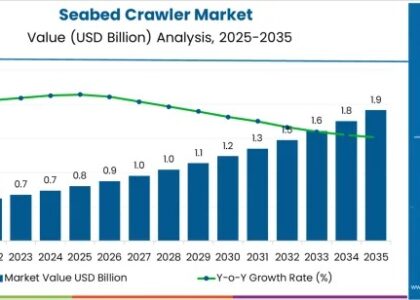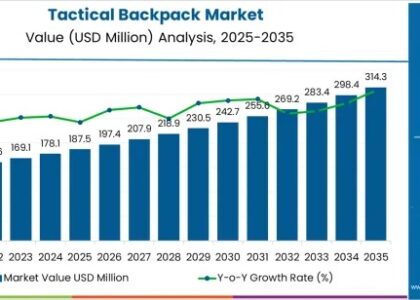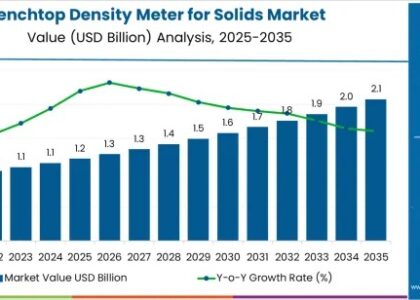
The electronic cartography market is set to experience steady growth between 2025 and 2035, driven by the escalating demand for high-precision navigation systems, advanced GIS-based analytics, and AI-powered mapping technologies. The market is projected to reach USD 32.26 billion in 2025 and expand to USD 48.74 billion by 2035, registering a robust compound annual growth rate (CAGR) of 10% over the forecast period. This growth is underpinned by increasing adoption across multiple sectors, including defense, automotive, maritime, aviation, urban planning, and environmental monitoring. As industries increasingly rely on real-time geospatial intelligence for operational efficiency and decision-making, electronic cartography is becoming an indispensable asset.
The growing integration of artificial intelligence, big data analytics, and cloud computing into cartographic platforms is transforming traditional mapping tools into dynamic, interactive systems capable of predictive modeling and real-time updates. From enabling precise fleet tracking and autonomous vehicle navigation to supporting disaster management and infrastructure development, electronic cartography offers immense utility. Governments and private sector players alike are investing heavily in upgrading mapping infrastructure to support smart city initiatives, transportation optimization, and environmental monitoring, further strengthening the growth trajectory of the market.
Request Your Sample and Stay Ahead with Our Insightful Report!
https://www.futuremarketinsights.com/reports/electronic-cartography-market
Key Takeaways from the Electronic Cartography Market
One of the core takeaways from the electronic cartography market is its increasingly critical role in data-driven navigation and spatial decision-making. Real-time mapping, enhanced by satellite imagery and geospatial sensors, is streamlining operations in logistics, emergency response, construction, and military strategy. The ability to collect, process, and visualize geospatial data in a digital format provides users with actionable insights that were previously difficult to obtain using traditional cartographic methods. This shift is enabling faster response times, route optimization, and better resource allocation across industries.
Another key takeaway is the rapid expansion of electronic chart display and information systems (ECDIS) in maritime and aviation sectors. These systems are not only replacing traditional paper-based navigation tools but are also integrating with other onboard technologies to provide comprehensive situational awareness. The rise of autonomous and remotely piloted systems in both commercial and defense settings has further accelerated demand for high-resolution digital maps capable of facilitating machine-readable pathfinding and object recognition. Additionally, consumers are increasingly exposed to mapping technologies through GPS-enabled apps, location-based services, and AR-enhanced navigation in retail and tourism settings.
Emerging Trends in the Global Electronic Cartography Market
Several notable trends are reshaping the landscape of electronic cartography. The rise of AI-based mapping platforms is one of the most significant shifts. These platforms are capable of learning from real-time data inputs and updating maps autonomously, which enhances accuracy and responsiveness. In urban environments, AI is being used to generate 3D maps for smart infrastructure planning and augmented reality applications. Machine learning algorithms are also helping map previously inaccessible terrains using satellite and drone data, particularly useful in disaster-prone or underdeveloped areas.
Another emerging trend is the adoption of open-source and crowd-sourced mapping solutions. Platforms like OpenStreetMap have democratized access to digital cartography, encouraging contributions from individuals and organizations worldwide. This has proven particularly beneficial for humanitarian organizations and NGOs operating in regions with limited commercial mapping coverage. Additionally, the integration of Internet of Things (IoT) devices with cartographic platforms is enhancing real-time data collection and analysis. Smart sensors embedded in vehicles, roads, and public infrastructure are providing live feedback that feeds directly into digital maps, improving accuracy and responsiveness for applications such as smart traffic systems and autonomous mobility.
Furthermore, the increasing deployment of 5G and satellite-based communication networks is improving the performance of online and cloud-based mapping platforms. Enhanced connectivity allows for faster data transmission, higher-resolution map updates, and broader coverage in remote or offshore locations. This trend is especially impactful in sectors like offshore oil exploration, ocean navigation, and remote area defense operations.
Significant Developments and Opportunities in the Sector
The electronic cartography market is seeing a surge in investment across both public and private sectors, presenting vast opportunities for solution providers and software developers. The development of smart cities is a significant growth driver, with urban planners relying on digital maps for zoning, infrastructure layout, utilities management, and traffic planning. Governments across Europe, Asia, and the Middle East are launching national geospatial strategies that prioritize the modernization of mapping systems and public access to spatial data.
Opportunities are also rising in environmental monitoring and conservation. Electronic cartography tools are being used to track deforestation, monitor air and water quality, and analyze climate change impacts using satellite data overlays. This application is gaining traction among environmental agencies, academic institutions, and renewable energy companies looking to evaluate land use patterns and ecological risk zones. Defense and homeland security sectors continue to invest in electronic cartography for surveillance, terrain analysis, and tactical mission planning, with increased demand for encrypted and tamper-proof map data.
As autonomous mobility solutions scale globally, automotive manufacturers and tech firms are partnering to develop HD maps with lane-level detail, road curvature data, and obstacle detection layers. These maps are foundational to the safe operation of self-driving cars, drones, and delivery robots. Startups focused on HD mapping and simulation environments are attracting significant venture capital, signaling a wave of innovation in digital cartography tailored for automation.
Recent Developments in the Market
Recent years have witnessed several key developments that underscore the market’s growing relevance. Leading mapping software providers have introduced AI-enhanced platforms capable of automatic route updates, terrain classification, and weather overlays. Major tech companies have expanded their satellite constellations and remote sensing capabilities, improving the granularity and refresh rates of digital maps. New partnerships between telecom operators and mapping firms are enabling real-time location analytics for fleet management and logistics optimization.
In 2024, a prominent GIS company unveiled a cloud-native geospatial intelligence platform that integrates with drones and IoT devices to support infrastructure inspections and emergency planning. Another major milestone was the integration of high-precision maps into augmented reality glasses, enabling hands-free navigation for warehouse workers, maintenance crews, and tourists. Additionally, regulatory bodies have begun standardizing map data formats and protocols to ensure interoperability across platforms and geographies.
Thorough Market Evaluation: Full Report
https://www.futuremarketinsights.com/reports/electronic-cartography-market
Competition Outlook in the Electronic Cartography Market
The electronic cartography market is characterized by strong competition among established tech giants, GIS software vendors, satellite imaging firms, and specialized startups. Key players in the market include Esri, Google LLC, HERE Technologies, TomTom International BV, Apple Inc., Garmin Ltd., Maxar Technologies, NavInfo Co. Ltd., DigitalGlobe Inc., and Trimble Inc. These companies are focusing on expanding their digital mapping capabilities, integrating AI and machine learning, and developing cloud-based solutions to meet growing demand across verticals.
Key Segmentations
Market segmentation includes application areas such as automotive navigation, marine and aviation navigation, defense and intelligence, urban planning, environmental monitoring, and tourism. Regionally, North America and Europe lead the market due to early technological adoption and high spending on defense and infrastructure, while Asia Pacific is emerging as a high-growth region due to rapid urbanization, smart city projects, and rising demand for location-based services.
About Future Market Insights (FMI)
Future Market Insights, Inc. (ESOMAR certified, recipient of the Stevie Award, and a member of the Greater New York Chamber of Commerce) offers profound insights into the driving factors that are boosting demand in the market. FMI stands as the leading global provider of market intelligence, advisory services, consulting, and events for the Packaging, Food and Beverage, Consumer Technology, Healthcare, Industrial, and Chemicals markets. With a vast team of 400 analysts worldwide, FMI provides global, regional, and local expertise on diverse domains and industry trends across more than 110 countries.
Contact Us:
Future Market Insights Inc.
Christiana Corporate, 200 Continental Drive,
Suite 401, Newark, Delaware – 19713, USA
T: +1-845-579-5705
For Sales Enquiries: sales@futuremarketinsights.com
Website: https://www.futuremarketinsights.com
LinkedIn| Twitter| Blogs | YouTube





